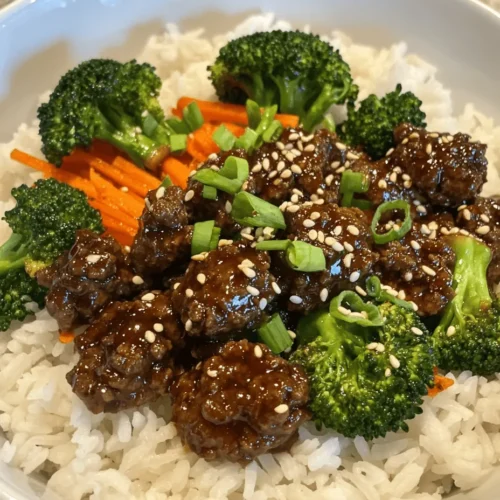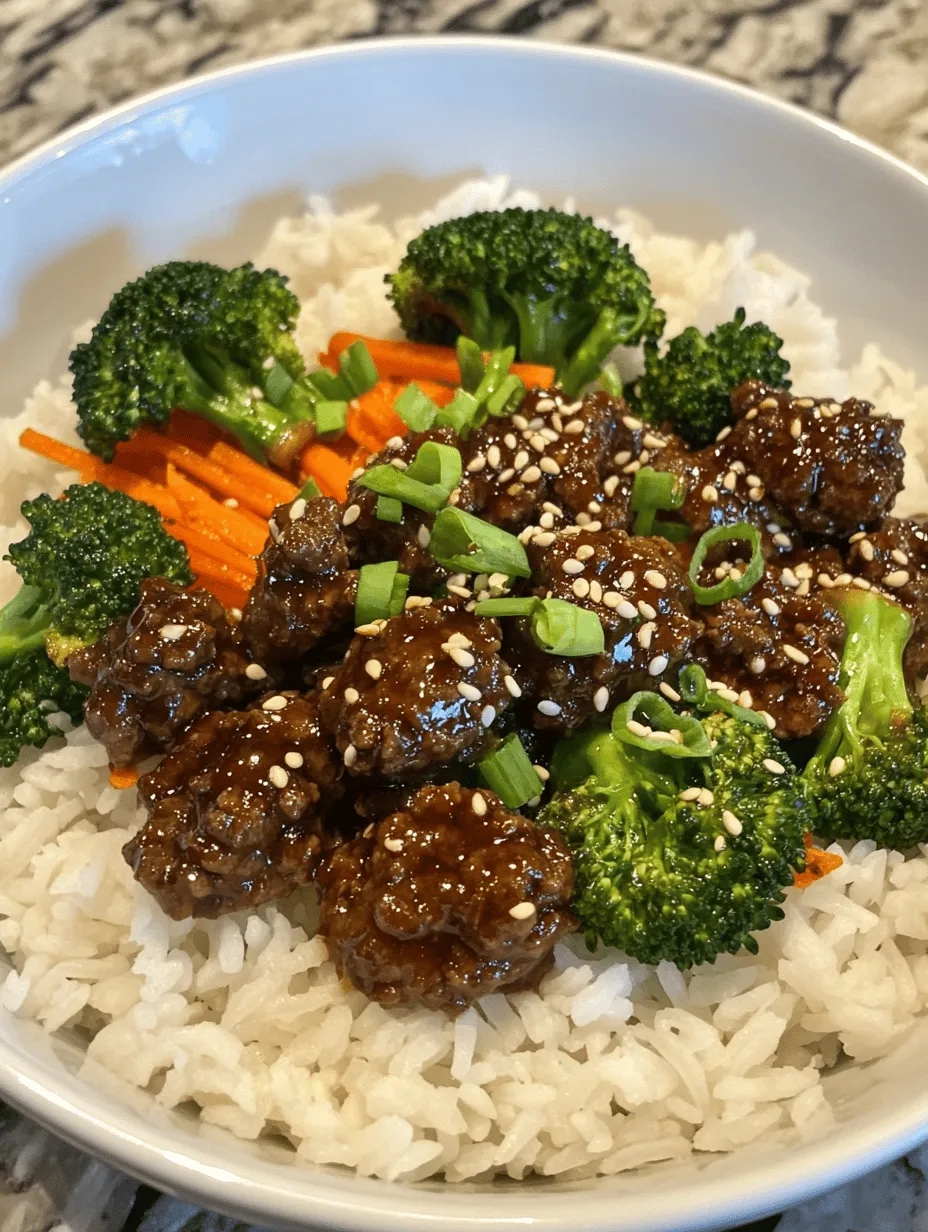Introduction
Korean cuisine has gained immense popularity in recent years, captivating food lovers around the globe with its bold flavors and unique combinations of ingredients. Known for its rich history and diverse offerings, Korean food ranges from spicy stews to savory barbecues, each dish telling a story of tradition and culture. One dish that embodies the essence of Korean cooking while also catering to the modern-day need for convenience is the Korean Ground Beef Bowl.
This delightful dish is not only quick to prepare but also bursting with flavor, making it an ideal choice for busy weeknight dinners or meal prepping for the week ahead. With its harmonious blend of savory, sweet, and spicy elements, the Korean Ground Beef Bowl can easily become a family favorite, satisfying both hearty appetites and culinary cravings.
Understanding the Ingredients
To create a truly authentic Korean Ground Beef Bowl, it’s essential to understand the key ingredients that contribute to its enticing flavor profile. Each ingredient plays a crucial role in bringing the dish to life, from the protein base to the aromatic seasonings and vegetables. Let’s delve into these components to see how they work together.
Ground Beef
At the heart of this dish is ground beef, which serves as a rich and flavorful protein source. When selecting ground beef, it’s important to consider the fat content, as this significantly influences both the flavor and texture of the dish. A blend of 80% lean meat to 20% fat is often recommended, as it provides a juicy, succulent bite without being overly greasy. The fat renders during cooking, imparting a luscious mouthfeel and enhancing the overall richness of the bowl.
Garlic and Ginger
Garlic and ginger are essential aromatics that elevate the dish’s flavor profile. Garlic adds a robust, earthy note while ginger introduces a bright, zesty taste. Together, they create a fragrant base that permeates the ground beef, lending warmth and depth to the overall flavor. When preparing the dish, finely mincing these ingredients ensures that their flavors are evenly distributed throughout.
Soy Sauce
Soy sauce is a cornerstone of Korean cuisine, providing a source of umami and saltiness that is crucial for seasoning the beef. This fermented condiment enhances the savory elements of the dish, balancing out the sweetness from the brown sugar and adding complexity. Opt for low-sodium soy sauce if you’re looking to control the saltiness while still achieving the desired flavor.
Brown Sugar
Brown sugar is an unexpected but delightful addition that helps balance the savory notes of the dish with a touch of sweetness. This sweetener not only enhances the flavor but also aids in caramelization when the beef is cooked, creating a delectable glaze that coats the meat. The molasses content in brown sugar gives it a rich flavor that complements the other ingredients beautifully.
Sesame Oil
Sesame oil is another vital ingredient in the Korean Ground Beef Bowl, contributing depth and richness to the overall taste. Its nutty aroma and flavor elevate the dish, making it more aromatic and satisfying. A little goes a long way; drizzle it in toward the end of the cooking process to maintain its distinct flavor.
Rice Vinegar
Adding a splash of rice vinegar introduces a tangy contrast that brightens the dish. This acidity helps cut through the richness of the beef and balances the sweetness of the brown sugar. It’s the perfect finishing touch that rounds out the flavor profile, ensuring that each bite is well-balanced and enjoyable.
Gochugaru
For those who enjoy a bit of heat, gochugaru, or Korean red pepper flakes, is essential in this recipe. This spice adds a distinct heat level while also infusing the dish with a vibrant red hue. Gochugaru is less spicy than other chili flakes and offers a mild sweetness, making it a great addition for those who may be sensitive to heat. Adjust the amount used to suit your personal spice preference.
Vegetables
Incorporating vegetables into the Korean Ground Beef Bowl not only enhances its nutritional profile but also adds color and texture. Common choices include bell peppers, carrots, and green onions, which contribute crunch and freshness. These vegetables can easily be customized based on what you have on hand or your personal tastes. Their inclusion not only makes the dish more wholesome but also allows for a more visually appealing presentation.
Preparation Steps
Now that we’ve explored the key ingredients that make up the Korean Ground Beef Bowl, let’s dive into the preparation process. Each step is designed to build flavor and ensure that every component comes together seamlessly.
1. Preparing the Sauce
The first step in making the Korean Ground Beef Bowl is to prepare the sauce. This step is crucial, as it allows the flavors to meld together before being added to the beef. In a small bowl, combine soy sauce, brown sugar, sesame oil, rice vinegar, and gochugaru. Whisk the ingredients together until the sugar dissolves completely. This step not only ensures that the sugar is evenly distributed but also allows the flavors to develop, making for a more cohesive dish.
2. Cooking the Beef
Next, heat a large skillet or wok over medium-high heat. Once hot, add a drizzle of cooking oil and let it heat for a minute. Carefully add the ground beef to the skillet, breaking it apart with a spatula as it cooks. For achieving perfect browning, allow the beef to sit undisturbed for a couple of minutes before stirring. This will help develop a nice crust on the meat, enhancing its flavor. Cook until the beef is browned and cooked through, usually around 5-7 minutes.
3. Adding Aromatics
Once the beef is nicely browned, it’s time to add the aromatics. Stir in the minced garlic and ginger, cooking them for about 30 seconds until fragrant. Be mindful not to overcook them, as burnt garlic can impart a bitter taste to the dish. The goal is to soften the aromatics and release their essential oils, creating a fragrant base for the dish.
4. Incorporating Vegetables
Finally, it’s time to add the vegetables. If you’re using bell peppers, carrots, or any other quick-cooking vegetables, toss them in at this stage. Stir-fry the mixture for an additional 2-3 minutes, just until the vegetables are tender-crisp. This technique helps maintain their vibrant colors and nutritional benefits while ensuring they don’t become mushy.
As you stir-fry the beef and vegetables, pour in the sauce you prepared earlier, allowing it to coat the meat and veggies evenly. Continue cooking for another minute or two, letting the sauce thicken slightly and meld with the other ingredients.
By following these preparation steps, you’ll set the stage for a delicious Korean Ground Beef Bowl that is not only easy to make but also bursting with flavor, perfect for any weeknight dinner.
Stay tuned for the next part, where we will explore serving suggestions and tips for making this dish even more enjoyable.

Mixing in the Sauce
Once the ground beef is cooked through and beautifully browned, it’s time to mix in the sauce. This crucial step ensures that every bite of your Korean Ground Beef Bowl is bursting with flavor.
1. Pour the Sauce: Start by pouring the prepared sauce mixture directly into the pan with the cooked ground beef. The sauce is typically a harmonious blend of soy sauce, brown sugar, sesame oil, garlic, and ginger, creating a rich and savory profile that epitomizes Korean cuisine.
2. Stir to Combine: Using a spatula, gently stir the mixture to ensure that the beef is evenly coated. This process not only enhances the flavor but also allows the sugars in the sauce to caramelize slightly, forming a beautifully glossy finish.
3. Simmer for Flavor: Allow the beef and sauce to simmer on low heat for about 2-3 minutes. This will help the flavors meld together while letting the sauce thicken just a bit. You’ll know it’s ready when the mixture is fragrant and the sauce clings to the meat.
Assembly of Bowls
Presentation matters, especially when it comes to a dish that is as vibrant and flavorful as a Korean Ground Beef Bowl. Here are some tips for assembling your bowls to create a visually appealing meal:
1. Base Layer: Start with a generous scoop of perfectly cooked rice, whether white, brown, or even cauliflower rice for a low-carb option. The rice serves as a hearty base and absorbs the delicious flavors of the beef.
2. Add the Beef: Spoon the sautéed ground beef mixture over the rice. Make sure to pile it high for an impressive look.
3. Vegetable Garnish: Top your bowl with a colorful array of vegetables. Consider using sliced green onions, shredded carrots, and finely chopped cucumbers. These not only add a crunch but also make the dish visually enticing.
4. Finish with Sesame Seeds: For a final touch, sprinkle toasted sesame seeds over the top. They add a nutty flavor and enhance the dish’s overall aesthetic.
5. Optional Toppings: Consider adding a fried egg on top for an extra layer of indulgence. The runny yolk can add creaminess to the dish. You could also drizzle some spicy gochujang sauce for a kick.
Nutritional Benefits
The Korean Ground Beef Bowl is not only delicious but also packed with nutrients, making it a wholesome meal option.
Breakdown of the Dish’s Nutritional Profile
1. Protein Content from Ground Beef: Ground beef is an excellent source of protein, providing essential amino acids required for muscle growth and repair. A typical serving can contain around 20-25 grams of protein, depending on the portion size, making it a filling and satisfying choice.
2. Fiber and Vitamins from Vegetables: Including a variety of vegetables in your bowl contributes fiber, vitamins, and minerals. For instance, carrots offer beta-carotene, which is great for vision, while cucumbers provide hydration and vitamin K. The more colorful your vegetable selection, the more nutrients you’re likely to get.
3. Healthy Fats from Sesame Oil: Sesame oil not only enhances flavor but also provides healthy fats that are beneficial for heart health. These fats can help lower bad cholesterol levels and reduce the risk of heart disease when consumed in moderation.
4. Discussion on How This Dish Fits into a Balanced Diet: The combination of protein, fiber, and healthy fats in the Korean Ground Beef Bowl makes it a balanced meal option. Pairing it with rice or other whole grains ensures a good source of carbohydrates, providing energy for your daily activities.
Serving Suggestions
To elevate your meal experience, consider these serving suggestions:
1. Side Dishes: Traditional Korean side dishes (banchan) complement the beef bowl beautifully. Kimchi, a staple in Korean cuisine, adds a spicy, tangy kick and is rich in probiotics. You might also serve pickled vegetables or a light seaweed salad for a refreshing contrast.
2. Variations to the Recipe for Dietary Preferences: If you’re catering to vegetarian diets, substitute the ground beef with textured vegetable protein (TVP) or crumbled tofu, seasoned with the same flavorful sauce. For a gluten-free option, use tamari instead of soy sauce and ensure your other ingredients are gluten-free.
3. Suggestions for Drinks: Pair your Korean Ground Beef Bowl with a refreshing drink, such as iced barley tea (bori-cha) or a sweetened iced green tea. For a more robust option, a light lager or a fruity soju can also complement the meal well.
Storing and Reheating
If you find yourself with leftovers, here are some best practices for storing and reheating to maintain the dish’s flavor and texture:
1. Best Practices for Storing Leftovers: Allow the beef mixture to cool completely before transferring it to an airtight container. It can be stored in the refrigerator for up to 3 days. For longer storage, consider freezing the beef mixture in a freezer-safe container, where it can last for up to 3 months. Always label with the date for easy tracking.
2. Tips for Reheating: When you’re ready to enjoy your leftovers, reheat the beef mixture on the stovetop over medium heat. Add a splash of water or broth to prevent it from drying out. Stir frequently until heated through. If you’re reheating rice, add a few drops of water and cover it while microwaving to steam it back to fluffy perfection.
Cultural Significance of Korean Cuisine
Korean cuisine is rich in tradition and history, reflecting the agricultural and cultural heritage of the Korean people.
Brief History of Korean Culinary Traditions
Korean food has evolved through centuries, influenced by geography, climate, and historical events. The use of fermented ingredients, such as kimchi and gochujang, is a hallmark of Korean cooking, originating from the need to preserve food in a time before refrigeration. These methods not only enhance flavor but also contribute to the health benefits of the cuisine.
The Growing Trend of Korean Food in Global Cuisine
In recent years, Korean cuisine has gained immense popularity worldwide, with dishes like bibimbap, bulgogi, and, of course, the Korean Ground Beef Bowl, making their way into mainstream dining. The vibrant flavors and emphasis on fresh ingredients have captivated food enthusiasts globally, leading to an increase in Korean restaurants and food trucks. Social media platforms have further fueled this trend, showcasing the aesthetic appeal of Korean dishes and making them more accessible to home cooks.
Conclusion
The Korean Ground Beef Bowl is a delightful combination of flavors and textures, offering a satisfying meal that can be prepared swiftly. From the savory ground beef coated in a sweet and tangy sauce to the fresh vegetables and fluffy rice, every component works harmoniously to create a dish that is both delicious and nutritious. With its flexible nature, this recipe can be easily adapted to suit various dietary preferences, making it approachable for everyone.
Encouragement to try making this dish at home can not only introduce you to the wonderful world of Korean cuisine but also provide a comforting and enriching dining experience. So why not gather your ingredients and dive into this culinary adventure? Your taste buds will thank you!



